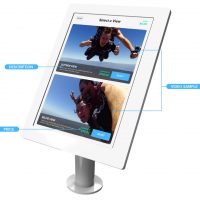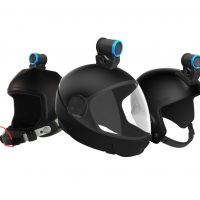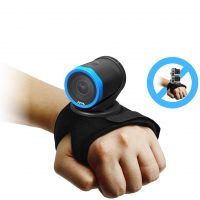

If you weren’t at this year’s PIA Symposium in Dallas, you may be unaware of a company that stirred up major buzz – Revl.
Revl has introduced a camera and editing system that many DZO’s in the industry are calling “game-changing.” The reason for this high praise is that the Revl system eliminates the use of editing entirely. Utilizing a Revl camera, a videographer or hand-cam tandem instructor simply walks in from the landing area, slots the camera into a black box and through the magic of all things marvelous, the system automatically edits the video and zips out four variations of the skydive to the consumer in under 20 minutes (dependant on your bandwidth speeds). These four videos vary from short clips designed for sharing to Instagram to the full “grannie” edit (aptly named as only your grannie would watch your entire 10-minute video with awkward interviews).
Here’s where things get interesting: artificial intelligence recognizes when things are out of place. For example, if an outside camera flyer leaves early before the TI, the system will automatically clip out all the footage of the camera flyer racing across the sky to close the gap. The system automatically stitches the footage together making it look seamless!
On top of that, Revl removes the pain point of having to stock USBs, to hire and train an editor, video failures (only 2 failures out of 17,000 videos shot in 2018), refunding, angry calls from customers and allows your camera flyers/instructors to walk in from the landing area and focus on prepping for the next load instead of dumping stills and video. There’s a big marketing implication as well: shareability. Revl’s interface allows the customer to modify their videos with music options and one-click sharing to social media that’s as seamless as any product I’ve seen in the marketplace.

So, this all sounds amazing… and it is! But, Revl has a divided audience of DZO’s. On one side, there are DZO’s that are early-adopters and see the system as revolutionary. On the other side, there are DZO’s who see this as a new company with an expensive product. This side is taking a “wait and see” approach as fear lies in the sustainability of the company… in other words, what happens if a DZ makes the investment into the Revl system and the company goes bust (Revl is a relatively young company).
This question has been accelerated following the end of PIA as reports from many DZO’s and DZM’s has showed that Revl had been slow to respond or in some cases, unresponsive, to e-mail inquiries or phone calls.
Due to the lack of response, there has been a lot of misinformation about the product as many DZO’s have been speaking to each other about the product and the continuing of one person’s message has morphed into a different set of facts.
Personally, I met the guys at Revl and I’m intrigued by their product. It seems that they have developed something with incredible promise to solve a ton of pain points. Having owned a video concession for seven years… I see the value in this system! I reached out to Revl’s, CEO, Eric Sanchez to see if he’d be willing to conduct an interview to set the record straight on their product costs, lapses in service and to answer several questions that my own clients have been asking me. I was pleasantly surprised to be joined on the phone by all three of the founders – Sanchez, Nelson Vazquez and Kirk Draheim. We had a two-hour interview and the highlights of that interview are below and are broken down into sections: customer service, pricing, and technical. It’s my hope that this article serves as a comprehensive piece to answer all the questions regarding Revl.
Revl – An interview with Eric, Nelson and Kirk
Customer Service
James: Let’s begin with the question of service. You blew everyone away at PIA and then after the symposium, it seemed that Revl went on radio silence with its communications. Many are feeling frustrated due to poor or no response times. What happened?
Eric: Simply put, we dropped the ball. We had not anticipated we’d receive such a big response to the product. So much so, that immediately after PIA, I was on a plane to the UK to meet with DZO’s to showcase our product there. We had over 100 e-mails and a lot of phone calls and we were unprepared for the response. What has made things worse is many of the replies we did make have been filtered to spam causing further delay in people receiving our messages.
James: Presently, three DZ’s are on the Revl system. How do you assure any of your future clients that they’ll receive better service than what they’ve seen after PIA?
Eric: We offer white-glove customer service to our clients. While we’ve only had three DZs on our system, we have other clients outside of the industry including the Audi Driving Experience and zip line operators. When it comes to service, we’re always going to put the most energy into the clients we have already. We recognize that some doubt was created by our poor response time and it was a miscalculation on our part as we didn’t expect the response to be so overwhelming.
Audi has been a customer of our Revl X service for 2 years and they’ve happily paid us over $2M so far, with many more orders coming in hot. If Revl can keep a premium world class car manufacturer happy they must be doing something right.
We recognize that we can’t screw this up if we’re going to build the trust of the industry. To ensure we don’t spread ourselves too thin, we’ve decided to limit the number of deployments to 25 DZs this season. We have gotten over 100 DZs inquiries for service so we are prioritizing on the ones that sign up quickly and have at least 3k+ jumps per year.
James: Let’s talk about the sustainability of your company. Through the years, the industry has seen many fly-by-night operators come and go with big ideas. What makes you any different?
Eric: All I can say is we’re not going anywhere anytime soon. We’ve received $7.5 million dollars in venture funding and we’ve generated $4 million in revenue. We anticipate another $7M to $10M in funding when we hit our 25 dropzone target set by our investors. The clients that we do have in the skydiving industry [Skydive San Diego, Skydive Puerto Rico and Skydive Hollister] are all happy with the product. Audi is a multi-million dollar client with more than 60,000 videos shot for Audi alone. The key message that I’d like to leave is we’re not screwing around. We’re not going to leave anyone high and dry with our equipment or our service.
Pricing
James: There are several moving parts as it relates to pricing. There are the hardware costs of the black box, cameras, editing credits and the need for an iPad. What are the costs associated with Revl?
Eric: We offer two pricing models for the hardware; an up-front purchase or a hardware lease. The lease starts at $1 extra per edit depending on the drop zone volume and hardware needed. If a DZ does in excess of 4,000 videos per year, the lease amount is an additional $1 per edit.

We have a new business model that works with all ranges of drop zones. We would figure out how much equipment they need based on a few factors like plane type and staff count, then we can offer to amortize the cost of the equipment over two years by adding a slight video extra charge per video. In most cases, it’s between $1 – and $1.75 per video. This way even the smallest dropzone has a chance to use our system.
James: So with the leasing option, the extra $1 is in perpetuity?
Eric: Yes.
James: Once hardware costs are paid, editing credits must be purchased. How does that work?
Nelson: We work like a prepaid cellphone plan. You can pay for credits for 1 month in advance. The amount deposited never expires and is only used when videos/photos are sold.

If you get a lot of customers in one month and run over the credits, the system will continue operating as normal and you will get billed for any overage charges. We do have an option to pre-sale the entire season or half season worth of credits upfront at a 10% discount. We are only doing that for this season.
SUPPORT
James: One of the big fears for any DZO is to have a video system breakdown on the weekend. This always raises the stress levels when wait times get long. What happens if something happens on the weekend; what support do you offer?
Nelson: Our support team works on weekends. We recognize that the weekends are the busiest times for our customers, so our customer support team is available on the weekend. The other major plus is our team has the ability to access the black boxes of our customers remotely which allows us to diagnose and correct any issues that may be occurring. Thus far, we haven’t had any issues with the system. There are some small human mistakes – one must ensure the light comes on when returning the camera into the black box.

James: From order placement, how long does it take to receive the product?
Eric: There is a pre-condition that has to be met before an order can be placed. Internet strength and good B-roll footage. (Estabilishing shots of the DZ, plane taking off, aerial shots of the landing area and generic landings. ). Once we’ve confirmed that the bandwidth can sustain the system, an order can be placed. Presently, we’re equipped to install one system a week with designs of increasing that to two systems per week. Depending on when someone places an order based on our install times will determine when the client is able to use the system. Essentially, it’s first come, first serve.
James: What’s involved with the installation?
Nelson: Usually, it’s a team of two of our team members. The installation and training usually takes one day and we’ll stay the whole weekend working with the DZ to ensure the install and transition is smooth.
James: Additionally, an iPad is required?
Eric: Yes, at least one iPad will be needed to associate the customer’s face to a QR code. The cheapest ipad only costs $320 right now.
General Questions from DZOs:
James: What kind of ROI can DZs expect to see?
Eric: The ROI is measurable in multiple forms. What’s the value of an organic video shared? It bears more weight than a simple ad. Shooting 4,000 videos per year is great, but to have 4,000 videos shared… this provides big value. Furthermore, what value is placed on discontinuing refunds? Additionally, what value do you place on ending 90% of calls inquiring about when they’ll receive their video?
James: So you’re saying refunding for videos becomes a thing of the past?
Eric: We’ve observed an 80% reduction in refunds at our current 3 drop zones.
James: Do DZs have access to the footage that’s shot for social media?
Eric: Yes. The same access they have now doesn’t change, plus it eliminates the need for hard drives or cloud-based subscriptions. The data is stored forever on the Revl cloud. Both raw and customer edits.
James: Your promo video shows the ability for the system to sell photo/video services up to six weeks after the jump. Do you have data to show the % of post jump sales conversion?
Eric: At the moment, the after-sales piece is still under development, but will be launching in a few months.
James: When the after-jump sales feature is launched, how will the DZ be compensated and can DZO’s clearly see who was on the jump in order to figure out which instructor or camera flyer needs to be compensated?
Eric: Funds are wired and the DZO can easily see who needs to get compensated for post-jump sales within the Revl admin dashboard.
James: How many people currently work at Revl?
Eric: 15.
James: If comparing the Revl camera to a GoPro in terms of video quality, what GoPro model is comparable?
Eric: The GoPro 5
James: Does Revl have sights on future camera upgrades?
Eric: Yes, that’s on the drawing board. Our focus is for the next camera upgrade to be comparable to the GoPro 7 in terms of video quality.
James: Are there any other updates you’re hoping to add to your system?
Eric: Yes. We have met with Dylan from Sigma and we are planning on integrating the Revl experience link to be attached to the Merits people get from Sigma. We’ve also been in talks with Franz from Burble to build integration within the Burble infrastructure.
Technical Questions
James: What is the wifi bandwidth needed to support your system?
Nelson: We recommend and upload speed of 10mbps or higher. Depending on your internet speed we can adjust the video and photo size (resolution) to be able to deliver the media.
For example, we can lower the recording resolution to 1080p and offer 2MP photos if the internet upload is too slow.

James: What size/brand or type tablet is needed for students to sign up on to get the QR code and video?
Nelson: We recommend the Apple iPad 9.7″ like this one. Any Apple iPad that can run iOS 12 is also compatible. If you have iPads available please check if they are upgradable to iOS 12 as listed here: https://support.apple.com/en-us/HT209051
James: What happens if there is downtime with wi-fi at the DZ?
Nelson: When the internet goes out, the system continues editing videos and photos and it stores them locally. Once the internet is back online, it will automatically resume uploading the media and delivering to customers.
The system can store up to 700 tandem jumps at 4K/8MP resolution, or over 2100 tandem jumps at 1080p/2MP resolution. That means that it could store various days of media without any problems if there is a big outage of internet service. Note that customers will not get their media until it is uploaded to the internet/cloud.

James: What happens if there is a problem on your end with the cloud?
Nelson: We use highly reliable and redundant servers (replicated all around the world) for storage and server hosting. We also have software engineers located all over the US covering all time zones and keeping an eye on any possible system fault.
We use Amazon S3 for data storage and Amazon EC2 for servers – the same servers Netflix uses. When’s the last time you heard of Netflix servers going down? Netflix decided it’s better to use Amazon servers instead of building their own because amazon does such a good job at it.
Amazon has the highest cloud reliability: https://www.enterprisetech.com/2015/01/06/aws-rates-highest-cloud-reliability/
More data on Amazon’s S3 reliability here: https://docs.aws.amazon.com/AmazonS3/latest/dev/DataDurability.html
James: What if any service is needed or required to the box or system?
Nelson: We have built the boxes with industrial grade materials and electronics to make sure it is highly reliable and durable. The system is fully serviceable remotely, meaning that as long as there is internet connection, our engineers can resolve any issues in the software, including software updates, and even full reinstallation of the software if ever needed.
If the box gets physically damaged (submerged in water, exposed to a fire, etc) then a replacement will be needed. In this case, we would have to send a replacement box to get you up and running quickly.
James: What is the turnaround time on camera repair if needed?
Nelson: We will provide you with one (1) extra spare camera in case one of them is damaged so you can switch them right away. The damaged camera can be shipped back to us and we will cross-ship a replacement. This could take about 3 to 5 business days.









